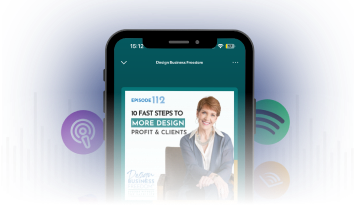6 Effective Ways to Overcome Design Client Objections
Facing client objections is an inevitable part of running a design business, but it doesn’t have to be a negative experience. In fact, objections can be an opportunity to educate your clients, build trust, and ultimately close more deals. This post will explore how to effectively overcome design client objections and turn them into a positive part of your design process.
1. Welcome Objections as Opportunities
Instead of dreading objections, view them as a sign that your client is interested and engaged. An objection indicates that the client is considering your proposal but needs more information to feel confident moving forward. This is your chance to clarify your value and educate them about the benefits of your services, helping you overcome design client objections effectively.
2. Keep the Focus on the Project, Not on You
When a client raises an objection, it’s crucial not to take it personally. Remember, the objection is about the proposal or the project details, not about you as a designer. By separating yourself from the design, you can address the objection more objectively and constructively, making it easier to overcome design client objections.
3. Educate, Don’t Defend
One of the biggest mistakes designers make when facing objections is immediately going on the defensive. Instead, use the opportunity to educate your client. For example, if a client questions your fees, explain how you arrived at that figure, detailing the value and outcomes they can expect from your work. This approach helps the client understand the rationale behind your pricing and builds trust, a key strategy to overcome design client objections.

4. Address Common Objections Head-On
Certain objections come up frequently in the design business, such as concerns about cost, timeline, or process. Being prepared to address these objections head-on can help you navigate them smoothly and overcome design client objections:
✔ Cost: When clients balk at your fees, don’t rush to lower them. Instead, explain the value they’re receiving and discuss how your fees align with the complexity and scope of the project. Only consider adjusting fees if there is a reduction in scope or complexity.
✔ Timeline: If a client objects to the timeline, be clear about what’s realistic given the scope of the project and external factors like supplier lead times. Reassure them that you prefer to under-promise and over-deliver rather than set unrealistic expectations.
✔ Process: If clients question your process, such as requiring all purchases to go through your firm, explain the benefits of maintaining control over the project. Highlight how this ensures quality and timely completion, which ultimately benefits them.
5. Use Testimonials and Success Stories
Sometimes, the best way to overcome an objection is to share a success story or testimonial from a previous client who had similar concerns. Real-life examples can be very persuasive and help potential clients see the value in your approach, making it easier to overcome design client objections.
6. Know When to Walk Away
Not every client will be the right fit, and that’s okay. If a client is unwilling to be educated, continues to push back on key aspects of your process, or exhibits red flags that suggest they could be difficult to work with, it might be best to walk away. Protecting your peace of mind and maintaining the integrity of your business is more important than landing a single project. Knowing when to walk away is also a vital part of learning how to overcome design client objections effectively.
Key Takeaway
Overcoming client objections is about creating a dialogue that builds trust and clarifies the value of your services. By welcoming objections, focusing on education, and staying firm on your process and pricing, you can turn potential roadblocks into opportunities for deeper client relationships and more successful projects.If you’re ready to increase your interior design practice profits, work exclusively with ideal clients, and enjoy the time and resources for your extraordinary life, explore your coaching options. We’ve got your back in the business of interior design.





